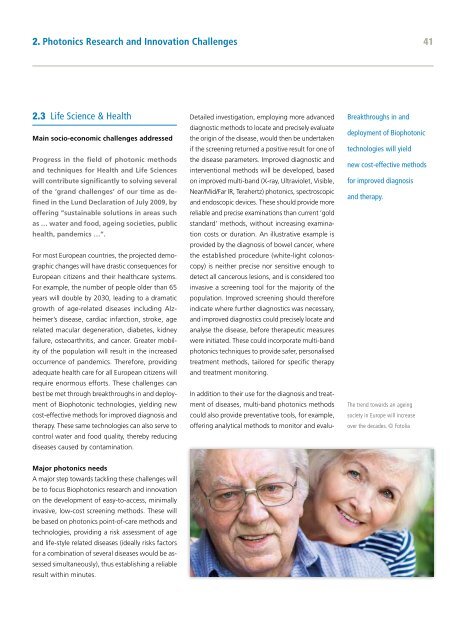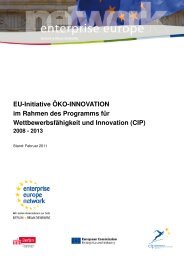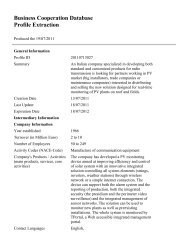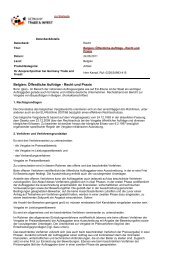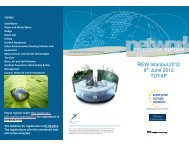Photonics Driving Economic Growth in Europe - Photonics21
Photonics Driving Economic Growth in Europe - Photonics21
Photonics Driving Economic Growth in Europe - Photonics21
Create successful ePaper yourself
Turn your PDF publications into a flip-book with our unique Google optimized e-Paper software.
2. <strong>Photonics</strong> Research and Innovation Challenges<br />
2.3 Life Science & Health<br />
Ma<strong>in</strong> socio-economic challenges addressed<br />
Progress <strong>in</strong> the field of photonic methods<br />
and techniques for Health and Life Sciences<br />
will contribute significantly to solv<strong>in</strong>g several<br />
of the ‘grand challenges’ of our time as de-<br />
f<strong>in</strong>ed <strong>in</strong> the Lund Declaration of July 2009, by<br />
offer<strong>in</strong>g “susta<strong>in</strong>able solutions <strong>in</strong> areas such<br />
as … water and food, age<strong>in</strong>g societies, public<br />
health, pandemics …”.<br />
For most <strong>Europe</strong>an countries, the projected demo-<br />
graphic changes will have drastic consequences for<br />
<strong>Europe</strong>an citizens and their healthcare systems.<br />
For example, the number of people older than 65<br />
years will double by 2030, lead<strong>in</strong>g to a dramatic<br />
growth of age-related diseases <strong>in</strong>clud<strong>in</strong>g Alzheimer’s<br />
disease, cardiac <strong>in</strong>farction, stroke, age<br />
related macular degeneration, diabetes, kidney<br />
failure, osteoarthritis, and cancer. Greater mobility<br />
of the population will result <strong>in</strong> the <strong>in</strong>creased<br />
occurrence of pandemics. Therefore, provid<strong>in</strong>g<br />
adequate health care for all <strong>Europe</strong>an citizens will<br />
require enormous efforts. These challenges can<br />
best be met through breakthroughs <strong>in</strong> and deployment<br />
of Biophotonic technologies, yield<strong>in</strong>g new<br />
cost-effective methods for improved diagnosis and<br />
therapy. These same technologies can also serve to<br />
control water and food quality, thereby reduc<strong>in</strong>g<br />
diseases caused by contam<strong>in</strong>ation.<br />
Major photonics needs<br />
A major step towards tackl<strong>in</strong>g these challenges will<br />
be to focus Biophotonics research and <strong>in</strong>novation<br />
on the development of easy-to-access, m<strong>in</strong>imally<br />
<strong>in</strong>vasive, low-cost screen<strong>in</strong>g methods. These will<br />
be based on photonics po<strong>in</strong>t-of-care methods and<br />
technologies, provid<strong>in</strong>g a risk assessment of age<br />
and life-style related diseases (ideally risks factors<br />
for a comb<strong>in</strong>ation of several diseases would be assessed<br />
simultaneously), thus establish<strong>in</strong>g a reliable<br />
result with<strong>in</strong> m<strong>in</strong>utes.<br />
Detailed <strong>in</strong>vestigation, employ<strong>in</strong>g more advanced<br />
diagnostic methods to locate and precisely evaluate<br />
the orig<strong>in</strong> of the disease, would then be undertaken<br />
if the screen<strong>in</strong>g returned a positive result for one of<br />
the disease parameters. Improved diagnostic and<br />
<strong>in</strong>terventional methods will be developed, based<br />
on improved multi-band (X-ray, Ultraviolet, Visible,<br />
Near/Mid/Far IR, Terahertz) photonics, spectroscopic<br />
and endoscopic devices. These should provide more<br />
reliable and precise exam<strong>in</strong>ations than current ‘gold<br />
standard’ methods, without <strong>in</strong>creas<strong>in</strong>g exam<strong>in</strong>ation<br />
costs or duration. An illustrative example is<br />
provided by the diagnosis of bowel cancer, where<br />
the established procedure (white-light colonoscopy)<br />
is neither precise nor sensitive enough to<br />
detect all cancerous lesions, and is considered too<br />
<strong>in</strong>vasive a screen<strong>in</strong>g tool for the majority of the<br />
population. Improved screen<strong>in</strong>g should therefore<br />
<strong>in</strong>dicate where further diagnostics was necessary,<br />
and improved diagnostics could precisely locate and<br />
analyse the disease, before therapeutic measures<br />
were <strong>in</strong>itiated. These could <strong>in</strong>corporate multi-band<br />
photonics techniques to provide safer, personalised<br />
treatment methods, tailored for specific therapy<br />
and treatment monitor<strong>in</strong>g.<br />
In addition to their use for the diagnosis and treatment<br />
of diseases, multi-band photonics methods<br />
could also provide preventative tools, for example,<br />
offer<strong>in</strong>g analytical methods to monitor and evalu-<br />
Breakthroughs <strong>in</strong> and<br />
deployment of Biophotonic<br />
technologies will yield<br />
new cost-effective methods<br />
for improved diagnosis<br />
and therapy.<br />
The trend towards an age<strong>in</strong>g<br />
society <strong>in</strong> <strong>Europe</strong> will <strong>in</strong>crease<br />
over the decades. © Fotolia<br />
41


